Green Eco-Driving Effects in Non-Congested Cities
Abstract
:1. Introduction
- Strategic decisions: vehicle selection and maintenance.
- Operational decisions: driving style geared to maintaining a constant speed, smooth acceleration, etc.
- Tactical decisions: route selection and vehicle load.
1.1. Eco-Driving
- Eco-drivers influence not only their own vehicle driving characteristics but also the surrounding vehicles and thus the traffic flow in the corridor.
- The effects of eco-driving are not the same on a local road as on an urban motorway and also depend on the traffic volumes.
- Eco-driving behaviour could produce more congestion; driving smoothly increases distances among cars, reducing density of road use. Therefore, when traffic flow increases, eco-driving could reduce the number of car per road section, increasing congestion accordingly.
1.2. Eco-Routing
2. Methodology
- Campaigns were organised to collect data on driver behaviour following routes with different types of city roads and traffic conditions. Four itineraries were selected with different levels of service (LOS). Level of Service is a quality measure describing operational conditions within a traffic stream; these conditions affect to speed and travel time, freedom to maneuver, traffic interruptions, and comfort and convenience. The test was first performed with drivers driving normally, and then a second set of car runs was recorded after they had taken an eco-driving course, following the same routes and at the same times of day.
- Individual driving variations produced by eco-driving were measured using an OBD-key (KBM Systems Ltd., London, UK) installed on board (see Section 2.5), the corresponding CO2 emissions savings were estimated also.
- The combined effects of route selection and eco-driving were calculated for the different types of urban road in the test city as a proxy for eco-routing.
- Drivers were surveyed to capture changes in their way of driving and perceptions once they were trained in eco-driving techniques.
2.1. Case Study: City of Caceres, Spain
2.2. Selecting Routes to Represent Different Road Types and Traffic Conditions
2.3. Driver Selection, Eco-Driving Training, and Assignment
- 1st period. Morning peak: 7:30–11:30 am
- 2nd period. Lunchtime: 12:00–4:00 pm
- 3rd period. Evening peak: 4:30–8:30 pm
2.4. Experimental Car Data Collection
2.5. Measured Variables
- GPS position (longitude and latitude) and distance travelled (km);
- Travel time (h);
- Instantaneous speed (km/h);
- Fuel consumption (L);
- Number of stops, rpm, acceleration, and deceleration (m/s2).
2.6. Survey to Capture Individual Driving Perceptions
3. Results
3.1. Driver Behaviour
- There is no significant difference in driving difficulty before and after eco-driving training. More than 90% of drivers consider vehicle handling easy (scores 1 and 2). This implies that the eco-driving technique is easy to learn and practice.
- The driving environment has very little influence, although some drivers admit to having more difficulty in bad traffic and weather conditions. Here, 74% of drivers consider the driving circumstances to be easy (scores 1 and 2) before eco-driving, while only 66% do so after eco-driving. Some 5% of eco-drivers reported difficult driving conditions (scores 6 and 7).
- The drivers’ feelings are modified with efficient driving. Here, 74% feel entertained before eco-training (scores 6 and 7) vs. 59% after eco-driving, and 15% of drivers therefore consider eco-driving to be less entertaining.
- Finally, it is worth noting that eco-driving causes a 10% decrease in drivers’ relaxation during the trip. Here, 79% of drivers are relaxed (scores 1 and 2) before eco-driving, compared to 68% who are afterwards.
3.2. Fuel Consumption and CO2 Emissions
3.3. Travel Times
4. Conclusions and Policy Recommendations
Acknowledgments
Author Contributions
Conflicts of Interest
Appendix A. Eco-Driving Course
Part 1—Theoretical (1 h) in a Group Class
Part 2—Practical (1 h) Individual
References
- Ramanathan, V.; Feng, Y. Air pollution, greenhouse gases and climate change: Global and regional perspectives. Atmos. Environ. 2009, 43, 37–50. [Google Scholar] [CrossRef]
- Emberger, G. Low carbon transport strategy in Europe—A critical review. Int. J. Sustain. Transp. 2015. [Google Scholar] [CrossRef]
- Energy Information Administration. International Energy Outlook; (No. DOE/EIA-0484(2017)); DOE: Washington, DC, USA, 2017. Available online: https://www.eia.gov/outlooks/ieo/pdf/0484(2017).pdf (accessed on 30 November 2017).
- Bottiglione, F.; Contursi, T.; Gentile, A.; Mantriota, G. The fuel economy of hybrid buses: The role of ancillaries in real urban driving. Energies 2014, 7, 4202–4220. [Google Scholar] [CrossRef]
- Li, Y.; Bao, L.; Li, W.; Deng, H. Inventory and policy reduction potential of greenhouse gas and pollutant emissions of road transportation industry in China. Sustainability 2016, 8, 1218. [Google Scholar] [CrossRef]
- Lin, Y.C.; Nguyen, H.L.T. Development of an eco-cruise control system based on digital topographical data. Inventions 2016, 1, 19. [Google Scholar] [CrossRef]
- Xia, H.; Boriboonsomsin, K.; Barth, M. Dynamic eco-driving for signalized arterial corridors and its indirect network-wide energy/emissions benefits. J. Intell. Transp. Syst. 2013, 17, 31–41. [Google Scholar] [CrossRef]
- Ahn, K.; Rakha, H. The effects of route choice decisions on vehicle energy consumption and emissions. Transp. Res. Part D 2008, 13, 151–167. [Google Scholar] [CrossRef]
- Instituto para la Diversificación y Ahorro de la Energía (IDAE). Plan de Acción de Ahorro y Eficiencia Energética 2011–2020. Spain, 2011. Available online: http://www.idae.es/uploads/documentos/documentos_11905_PAEE_2011_2020._A2011_A_a1e6383b.pdf (accessed on 12 May 2017).
- FIAT ECO-DRIVE. Eco-Driving Uncovered—The Benefit and Challenges of Eco-Driving, Based on the First Study Using Real Journey Data. 2010. Available online: www.fiat.com/ecodrive (accessed on 14 December 2017).
- Sivak, M.; Schoettle, B. Eco-driving: Strategic, tactical, and operational decisions of the driver that influence vehicle fuel economy. Transp. Policy 2012, 22, 96–99. [Google Scholar] [CrossRef]
- Barkenbus, J.N. Eco-driving: An overlooked climate change initiative. Energy Policy 2010, 38, 762–769. [Google Scholar] [CrossRef]
- Ecowill. The Golden Rules of Eco-Driving. 2013. Available online: http://cieca.eu/sites/default/files/documents/projects_and_studies/ECOWILL_FINAL_REPORT.pdf (accessed on 12 May 2017).
- IDAE. Conducción Eficiente. Controlas tu Energía. 2015. Available online: http://www.controlastuenergia.gob.es/consumo-inteligente/Paginas/conduccion-eficiente.aspx (accessed on 12 May 2017).
- Wilbers, P.; Wardenaar, H. The Dutch National Ecodriving Programme Het Nieuwe Rijden: A Success Story. In ECEEE 2007 Summer Study, Saving Energy—Just Do It! ECEEE Secretariat: Stockholm, Sweden, 2007; Available online: http://www.eceee.org/static/media/uploads/site-2/library/conference_proceedings/eceee_Summer_Studies/2007/Panel_8/8.111/paper.pdf (accessed on 26 June 2017).
- Garcia-Castro, A.; Monzon, A. Using floating car data to analyse the effects of its measures and eco-driving. Sensors 2014, 14, 21358–21374. [Google Scholar] [CrossRef] [PubMed]
- Kobayashi, I.; Tsubota, Y.; Kawashima, H. Eco-driving simulation: Evaluation of eco-driving within a network using traffic simulation. Urban Transp. XIII 2007. [Google Scholar] [CrossRef]
- Orfila, O. Impact of the Penetration Rate of Ecodriving on Fuel Consumption and Traffic Congestion. In YRS11: Young Researchers Seminar; ECTRI: Bruxelles, Belgien, 2011; Available online: http://www.ectri.org/YRS11/Documents/Final%20website/Session%2014/YRS11_Session14_OrfilaIFSTTAR.pdf (accessed on 26 June 2017).
- Garcia-Castro, A.; Monzon, A.; Valdes, C.; Romana, M. Modelling different penetration rates of eco-driving in urban areas. Impacts on traffic flow and emissions. Int. J. Sustain. Transp. 2017, 11, 282–294. [Google Scholar]
- Boriboonsomsin, K.; Barth, M.J.; Zhu, W.; Vu, A. Eco-routing navigation system based on multisource historical and real-time traffic information. IEEE Trans. Intell. Transp. Syst. 2012, 13, 1694–1704. [Google Scholar] [CrossRef]
- Boriboonsomsin, K.; Dean, J.; Barth, M. Examination of attributes and value of ecologically friendly route choices. Transp. Res. Rec. 2014, 2427, 13–25. [Google Scholar] [CrossRef]
- Yao, E.; Song, Y. Study on eco-route planning algorithm and environmental impact assessment. J. Intell. Transp. Syst. 2014, 17, 42–53. [Google Scholar] [CrossRef]
- Guo, L.; Huang, S.; Sadek, A.W. An evaluation of environmental benefits of time-dependent green routing in the greater Buffalo–Niagara region. J. Intell. Transp. Syst. 2013, 17, 18–30. [Google Scholar] [CrossRef]
- Bandeira, J.M.; Almeida, T.G.; Khattak, A.J.; Rouphail, N.M.; Coelho, M.C. Generating emissions information for route selection: Experimental monitoring and routes characterization. J. Intell. Transp. Syst. 2013, 17, 3–17. [Google Scholar] [CrossRef]
- Mensing, F.; Bideaux, E.; Trigui, R.; Ribet, J.; Jeanneret, B. Eco-driving: An economic or ecologic driving style? Transp. Res. Part C 2013, 38, 110–121. [Google Scholar] [CrossRef]
- Ericsson, E.; Larsson, H.; Brundell-Freij, K. Optimizing route choice for lowest fuel consumption–potential effects of a new driver support tool. Transp. Res. Part C 2006, 14, 369–383. [Google Scholar] [CrossRef]
- Ahn, K.; Rakha, H. Network-wide impacts of eco-routing strategies: A large scale case study. Transp. Res. Part D 2013, 25, 119–130. [Google Scholar] [CrossRef]
- Kono, T.; Fushiki, T.; Asada, K.; Nakano, K. Fuel Consumption Analysis and Prediction Model for “Eco” Route Search. In Proceedings of the 15th World Congress on Intelligent Transport Systems and ITS America’s, New York, NY, USA, 16–20 November 2008; Available online: https://trid.trb.org/view/902235 (accessed on 22 December 2017).
- Perez-Prada, F.; Monzon, A.; Valdes, C. Managing traffic flows for cleaner cities: The role of green navigation systems. Energies 2017, 10, 791. [Google Scholar] [CrossRef]
- Ericsson, E. Independent driving pattern factors and their influence on fuel-use and exhaust emission factors. Transp. Res. Part D 2001, 6, 325–345. [Google Scholar] [CrossRef]
- UNESCO (United Nations, Educational, Scientific and Cultural Organization). Available online: http://www.ciudadespatrimonio.org/ciudades/index.php?cd=3 (accessed on 18 July 2017).
- Ayuntamiento de Cáceres. Plan de Infraestructuras para la Movilidad Urbana Sostenible. 2014. Available online: http://zetaestaticos.com/comun/upload/0/580/580017.pdf (accessed on 12 May 2017).
- Ayuntamiento de Cáceres. Estudio de Tráfico y Movilidad. Revisión y Adaptación del Plan General Municipal de Cáceres. 2010. Available online: http://sig.caceres.es/PGM2010/TOMO_VI_EST_TRAFICO/ESTUDIO_DE_TRAFICO_REFUNDIDO.pdf (accessed on 13 June 2017).
- U.S. Department of Transportation. Highway Functional Classification: Concepts, Criteria and Procedure. 2013. Available online: https://www.fhwa.dot.gov/planning/processes/statewide/related/highway_functional_classifications/fcauab.pdf (accessed on 12 May 2017).
- Dirección General de Tráfico. Censo Conductores 2016. Available online: http://www.dgt.es/Galerias/seguridad-vial/estadisticas-e-indicadores/censo-conductores/tablas-estadisticas/2016/censo_2016_anuario.xlsx (accessed on 1 December 2017).
- Dirección General de Tráfico. Parque de Vehículos por Provincias. 2016. Available online: http://www.dgt.es/es/seguridad-vial/estadisticas-e-indicadores/parque-vehiculos/tablas-estadisticas/ (accessed on 20 July 2017).
- Instituto para la Diversificación y Ahorro de la Energía (IDAE). Consumo de Carburante y Emisiones de CO2 en Coches Nuevos. 2017. Available online: http://coches.idae.es/portal/BaseDatos/MarcaModelo.aspx (accessed on 13 June 2017).
- OBDKEY. 2017. Available online: http://www.obdkey.com (accessed on 12 May 2017).
- Nemoto, T.; Beglar, D.; Questionnaires, L.-S.; Sonda, N.; Krause, A. JALT2013 Conference Proceedings. Tokyo: JALT. 2014. Available online: http://jalt-publications.org/files/pdf-article/jalt2013_001.pdf (accessed on 18 July 2017).
- Staubach, M.; Schebitz, N.; Krehle, T.; Oeltze, K.; Kuck, D. User Acceptance of an Eco-Driving Support System. In Proceedings of the 9th ITS European Congress, Dublin, Ireland, 4–7 June 2013; Available online: http://www.ecomove-project.eu/assets/Documents/Presentations/ITS-Dublin-2013/ITSDublin-paper366Staubach.pdf (accessed on 18 December 2017).
- European Environmental Agency. Total Greenhouse Gas Emissions Trends and Projections. Available online: https://www.eea.europa.eu/data-and-maps/indicators/greenhouse-gas-emission-trends-6 (accessed on 18 October 2017).
- International Energy Agency. CO2 Emissions from Fuel Combustion. Available online: https://www.iea.org/statistics/relateddatabases/co2emissionsfromfuelcombustion/ (accessed on 18 October 2017).
- Bifulco, G.N.; Galante, F.; Pariota, L.; Spena, M.R. A linear model for the estimation of fuel consumption and the impact evaluation of advanced driving assistance systems. Sustainability 2015, 7, 14326–14343. [Google Scholar] [CrossRef]
- ICT-Emissions Project “Development of a Methodology and Tool to Evaluate the Impact of ICT Measures on Road Transport Emissions”. Available online: http://www.ict-emissions.eu/ (accessed on 26 June 2017).
- Baptista, P.C.; Azevedo, I.L.; Farias, T.L. ICT solutions in transportation systems: Estimating the benefits and environmental impacts in the Lisbon. Procedia-Soc. Behav. Sci. 2012, 54, 716–725. [Google Scholar] [CrossRef]
- Perez-Prada, F.; Monzon, A. Ex-post environmental and traffic assessment of a speed reduction strategy in Madrid’s inner ring-road. J. Transp. Geogr. 2017, 58, 256–268. [Google Scholar] [CrossRef]
- Hickman, R.; Ashiru, O.; Banister, D. Transport and climate change: Simulating the options for carbon reduction in London. Transp. Policy 2010, 17, 110–125. [Google Scholar] [CrossRef]
- Ma, H.; He, G. Effects of the post-olympics driving restrictions on air quality in Beijing. Sustainability 2016, 8, 902. [Google Scholar] [CrossRef]
- Barth, M.; Boriboonsomsin, K. Energy and emissions impacts of a freeway-based dynamic eco-driving system. Transp. Res. Part D 2009, 14, 400–410. [Google Scholar] [CrossRef]
- Qian, G.; Chung, E. Evaluating Effects of Eco-Driving at Traffic Intersections Based on Traffic Micro-Simulation. In Proceedings of the 34th Australasian Transport Research Forum (ATRF), Adelaide, Australia, 28–30 September 2011; Available online: https://eprints.qut.edu.au/45778/1/ATRF11_0092_revised.pdf (accessed on 26 June 2017).
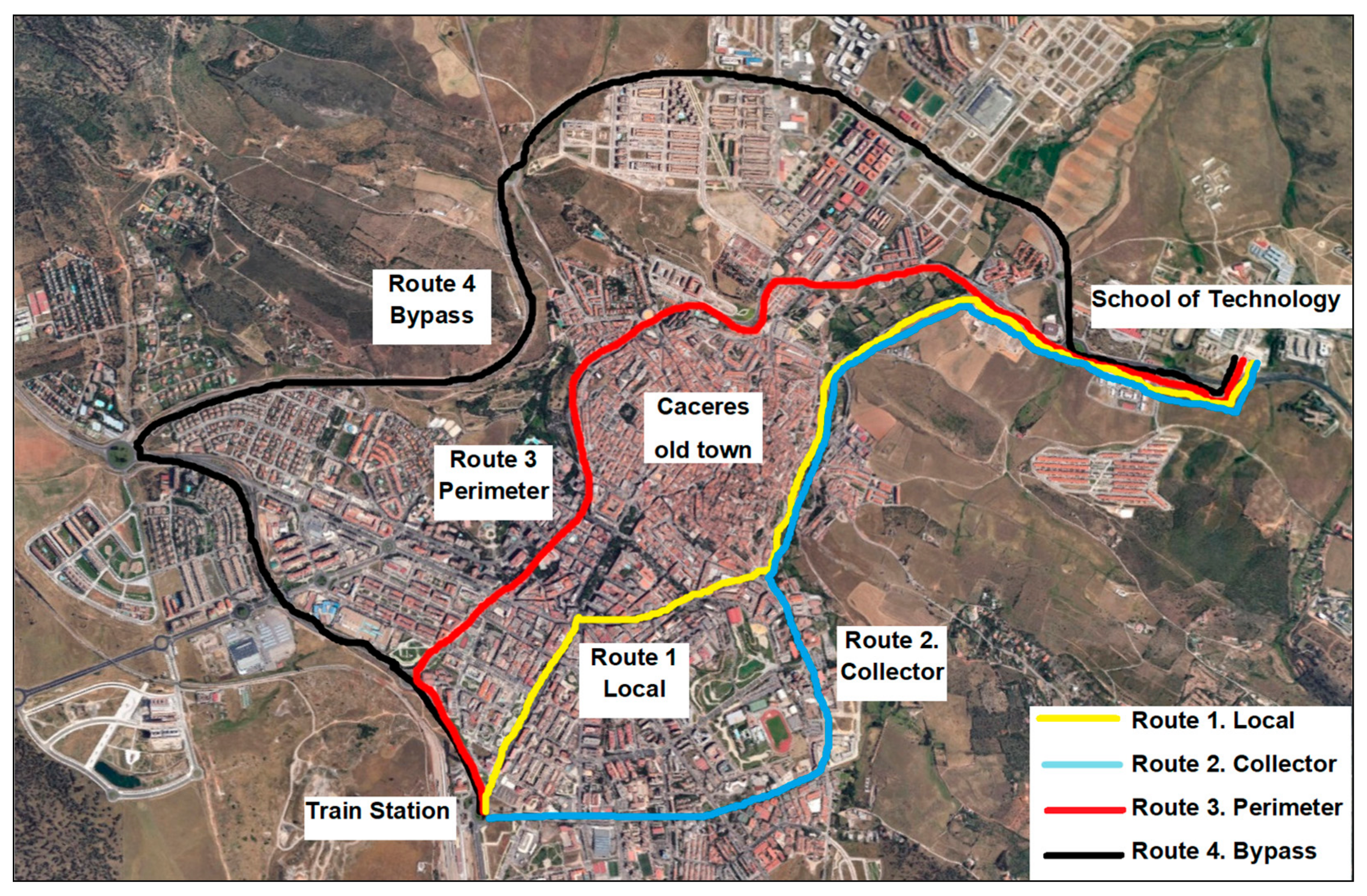

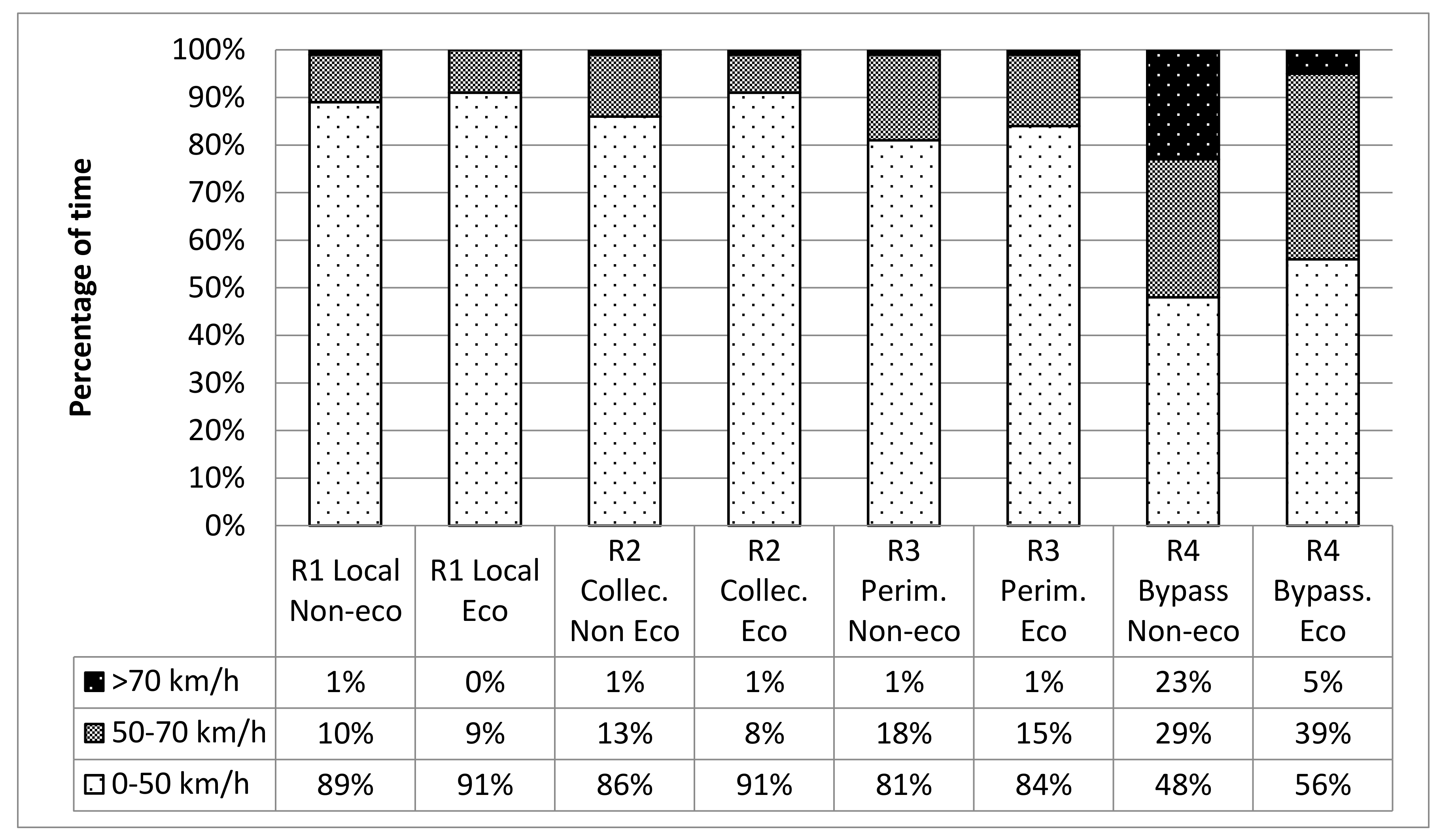
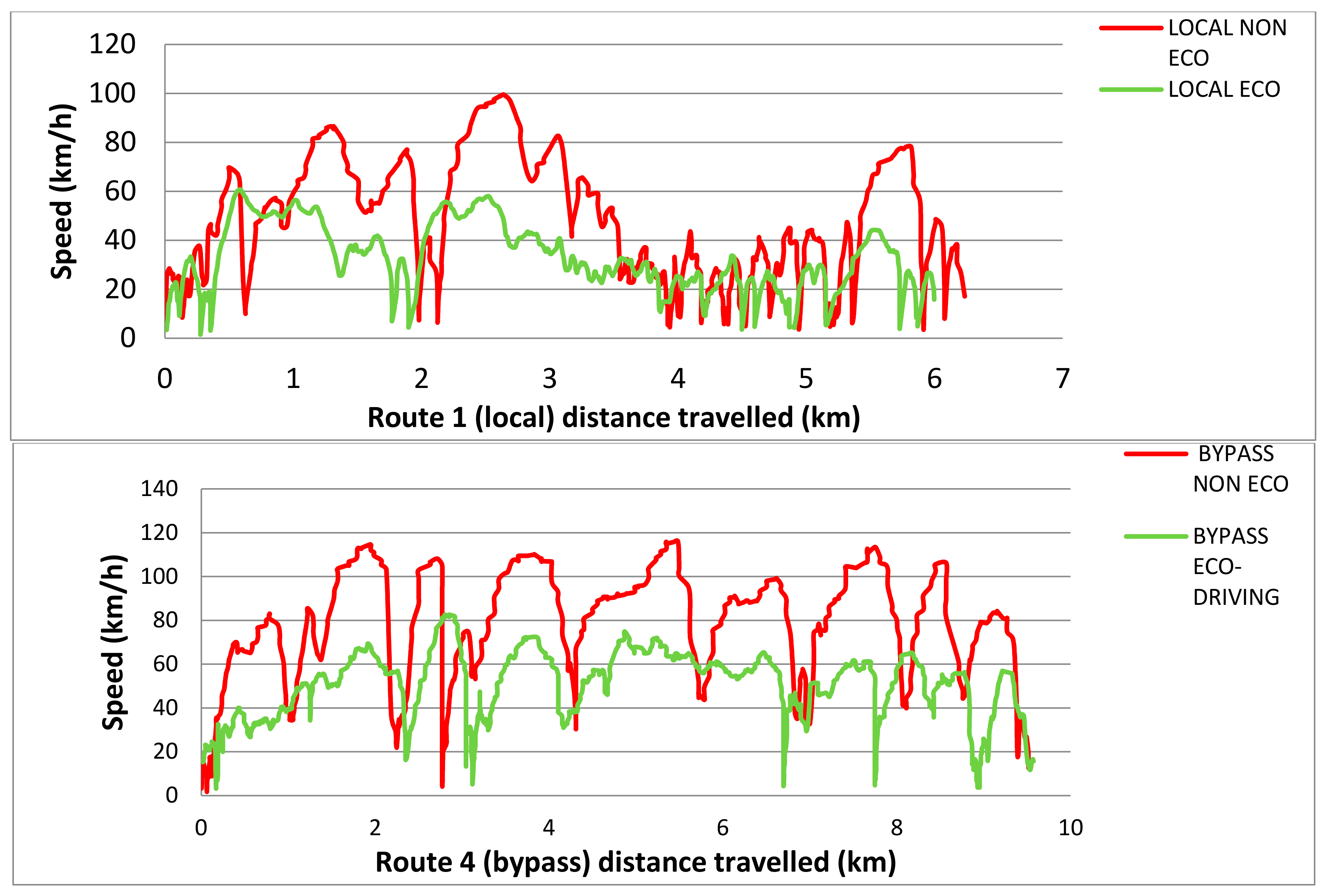
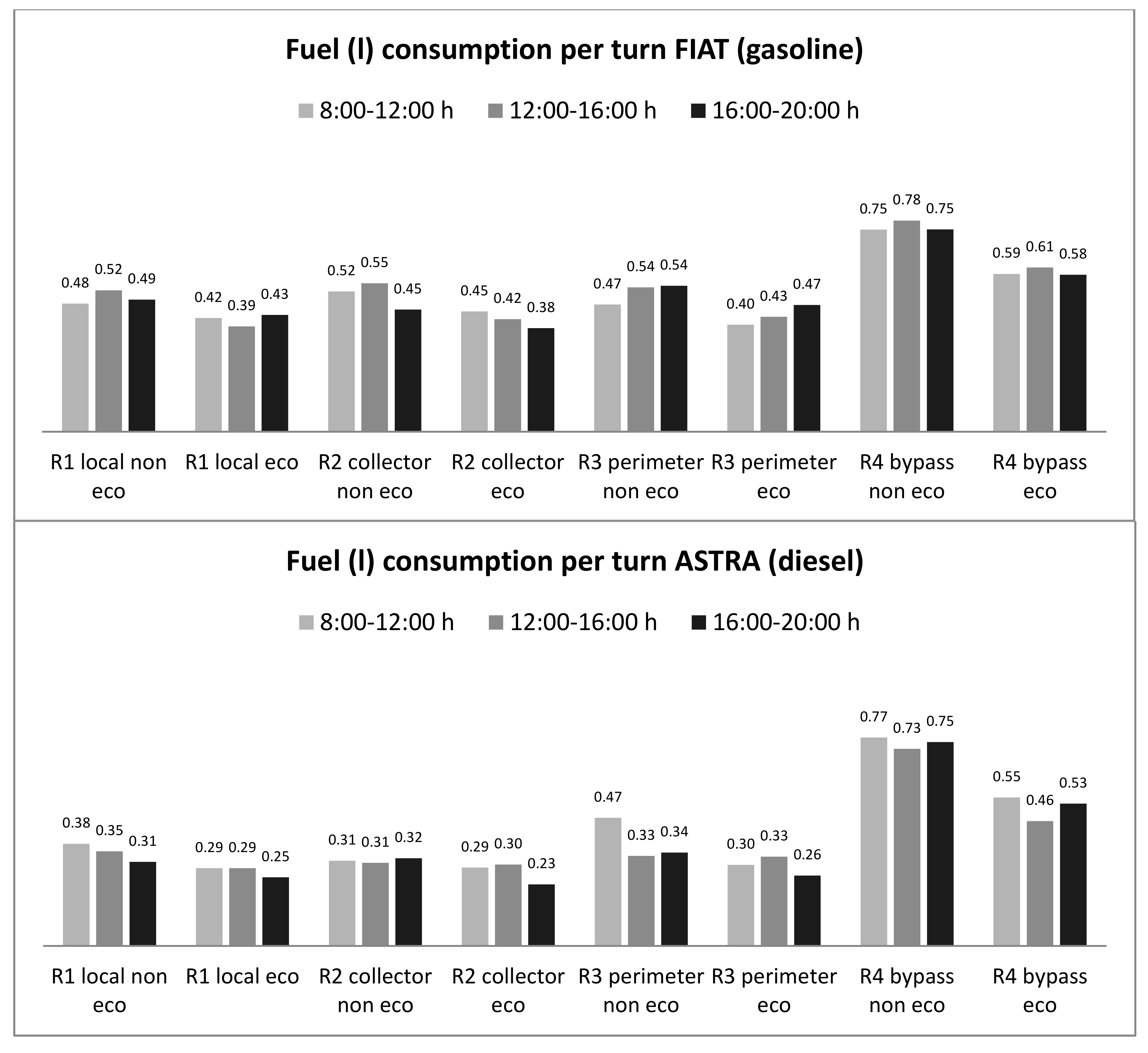
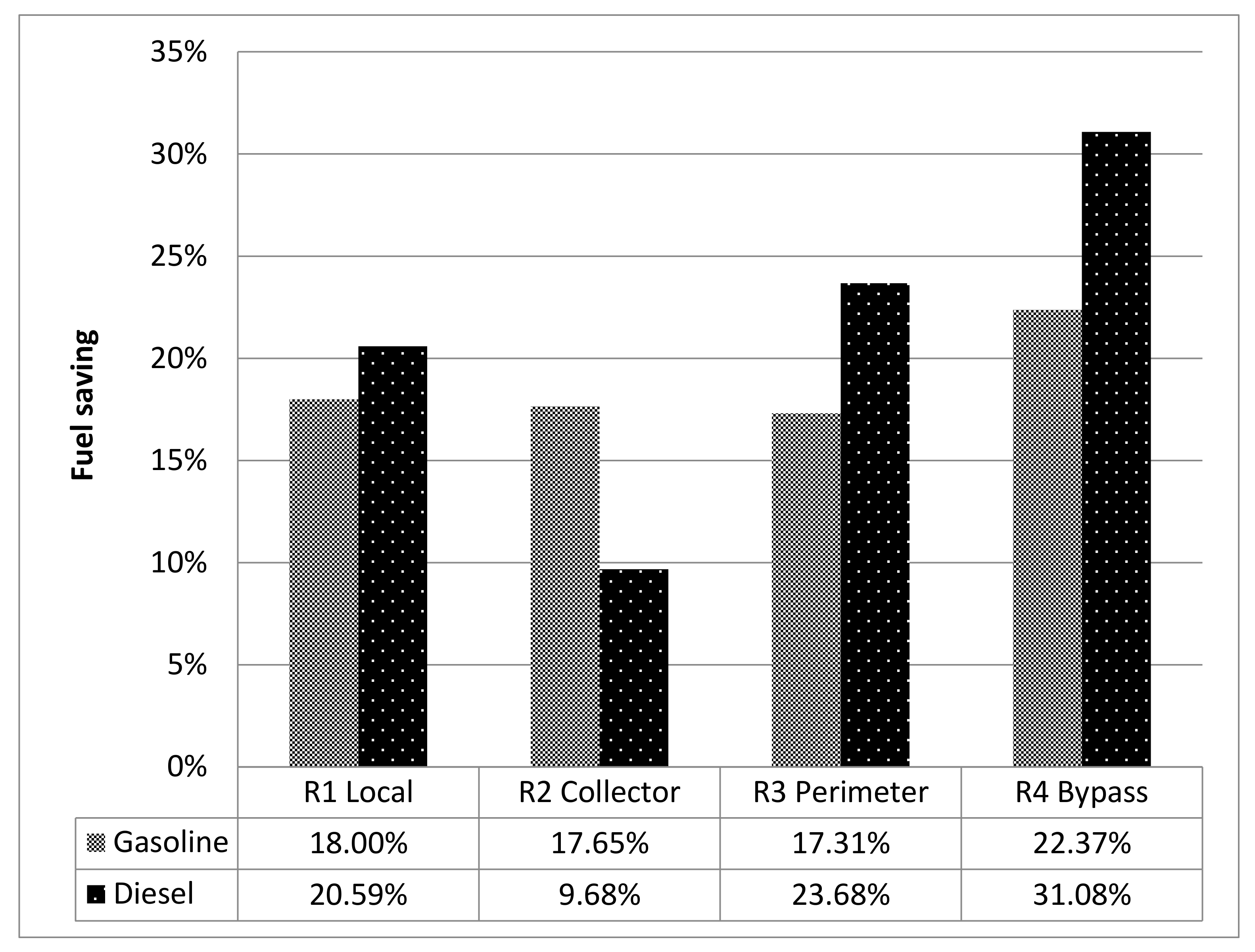
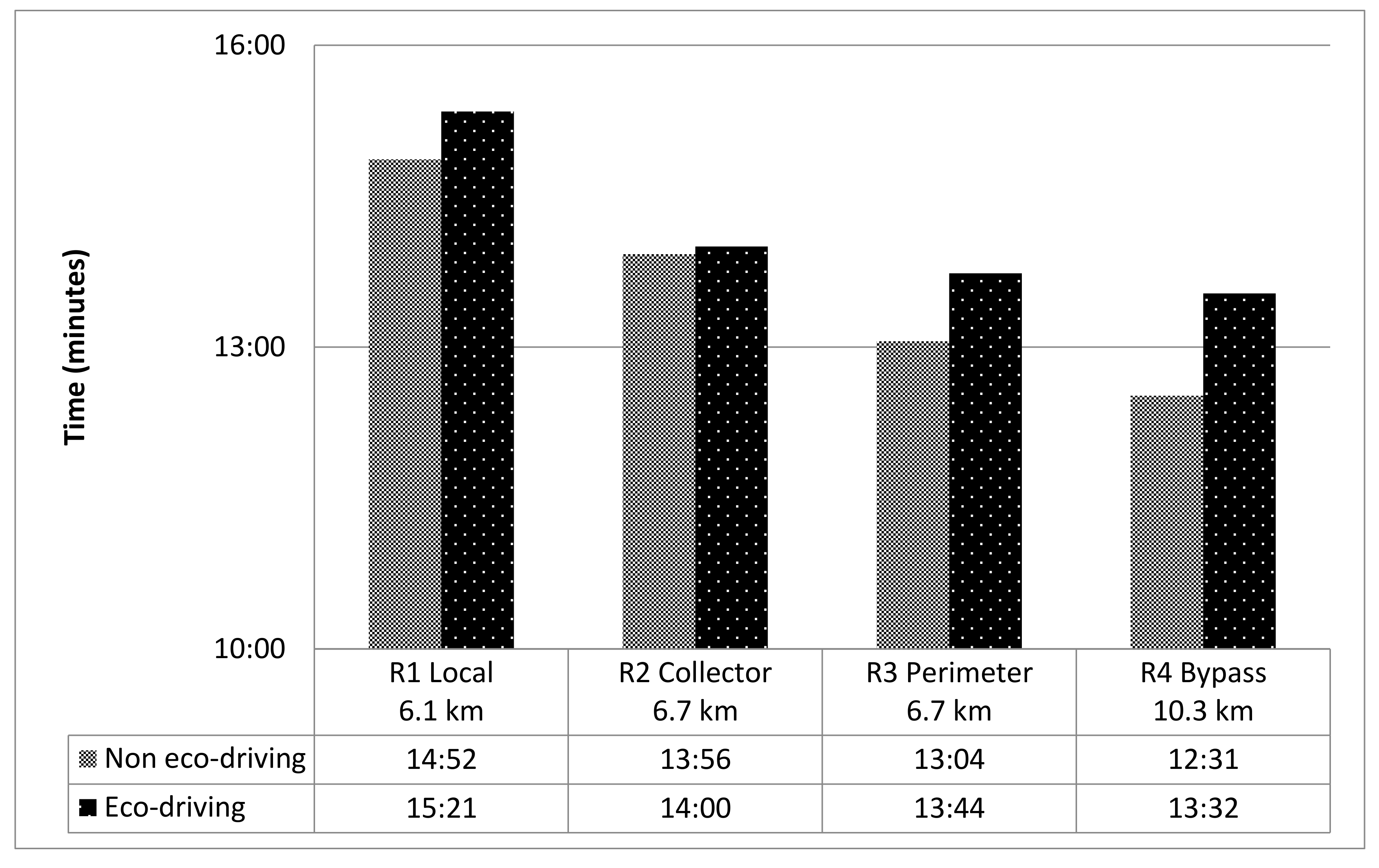
| Features | Astra | Fiat |
|---|---|---|
| Commercial classification | Saloon | Mini |
| Gear shift type | Manual | Manual |
| Maximum authorized mass | 2010 | 1305 |
| HP power | 110.05 | 93.75 |
| Dimensions (LxWxH) (mm) | 4419 × 1814 × 1510 | 3546 × 1627 × 1488 |
| Seats | 5 | 4 |
| Emissions (gCO2/km) | 109 | 115 |
| Emissions (gCO2/L) | 2658 | 2347 |
| Classification by relative consumption |  |  |
| Vehicle | Total Km Travelled | Route 1 Local | Route 2 Collector | Route 3 Perimeter | Route 4 Bypass | Total | Men | Women | |
|---|---|---|---|---|---|---|---|---|---|
| Non-eco-driving | Astra | 1010 | 39 | 35 | 35 | 39 | 148 | 187 | 103 |
| Fiat | 1091 | 40 | 34 | 34 | 34 | 142 | |||
| Eco-driving | Astra | 1022 | 41 | 32 | 34 | 38 | 145 | 190 | 100 |
| Fiat | 1045 | 37 | 35 | 37 | 36 | 145 | |||
| Total | 4168 | 157 | 136 | 140 | 147 | 580 | 377 | 203 |
| Parameters | Driving Mode | R1 Local | R2 Collector | R3 Perimeter | R4 Bypass |
|---|---|---|---|---|---|
| Average rpm | Non-eco | 1439.85 | 1493.36 | 1584.79 | 1811.81 |
| Eco-driving | 1246.54 | 1241.85 | 1267.33 | 1330.95 | |
| Max rpm | Non-eco | 3506.21 | 3406.55 | 3535.95 | 3740.99 |
| Eco-driving | 2787.63 | 3001.73 | 3046.17 | 2879.58 | |
| Max positive acceleration m/s2 | Non-eco | 2.31 | 2.07 | 2.25 | 2.66 |
| Eco-driving | 1.86 | 1.80 | 2.19 | 2.24 | |
| Max negative acceleration m/s2 | Non-eco | −2.35 | −2.31 | −2.54 | −2.95 |
| Eco-driving | −2.08 | −2.13 | −2.26 | −2.34 | |
| Average positive acceleration m/s2 | Non-eco | 0.35 | 0.36 | 0.44 | 0.54 |
| Eco-driving | 0.34 | 0.34 | 0.37 | 0.36 | |
| Average negative acceleration m/s2 | Non-eco | −0.41 | −0.40 | −0.48 | −0.57 |
| Eco-driving | −0.38 | −0.37 | −0.40 | −0.39 | |
| Average number of times driving below 5 km/h | Non-eco | 6.54 | 4.97 | 4.97 | 3.01 |
| Eco-driving | 6.27 | 4.75 | 5.10 | 2.31 |
| Questions | Driving | Answers (%) | ||||||
|---|---|---|---|---|---|---|---|---|
| Mode | 1 | 2 | 3 | 4 | 5 | 6 | 7 | |
| Driving the vehicle was easy (1)—difficult (7). | Non-eco | 72 | 20 | - | 4 | 4 | - | - |
| Eco | 63 | 31 | 3 | - | 3 | - | - | |
| The driving environment was easy (1)—difficult (7) | Non-eco | 45 | 29 | 13 | 6 | 7 | - | - |
| Eco | 33 | 33 | 14 | 11 | 4 | 4 | 1 | |
| During the trip you were bored (1)—entertained (7) | Non-eco | - | 1 | 3 | 7 | 13 | 34 | 40 |
| Eco | - | 4 | 8 | 11 | 18 | 31 | 28 | |
| During the trip you felt relaxed (1)—stressed (7) | Non-eco | 52 | 27 | 10 | 4 | 6 | - | 1 |
| Eco | 34 | 34 | 15 | 4 | 10 | 3 | - | |
| Vehicle | Parameter | Non-Eco-Driving | Eco-Driving | ||||||
|---|---|---|---|---|---|---|---|---|---|
| R1 Local | R2 Collector | R3 Perimeter | R4 Bypass | R1 Local | R2 Collector | R3 Perimeter | R4 Bypass | ||
| Fiat (gasoline) | Fuel (L) | 0.50 | 0.51 | 0.52 | 0.76 | 0.41 | 0.42 | 0.43 | 0.59 |
| Fuel (L/100 km) | 8.44 | 8.03 | 8.06 | 7.54 | 6.96 | 6.63 | 6.69 | 5.84 | |
| estimated CO2 (g) | 1173.50 | 1196.97 | 1220.44 | 1783.72 | 962.27 | 985.74 | 1009.21 | 1384.73 | |
| Astra (diesel) | Fuel (L) | 0.34 | 0.31 | 0.38 | 0.74 | 0.27 | 0.28 | 0.29 | 0.51 |
| Fuel (L/100 km) | 5.76 | 4.84 | 5.90 | 7.39 | 4.53 | 4.45 | 4.56 | 5.09 | |
| estimated CO2 (g) | 903.72 | 823.98 | 1010.04 | 1966.92 | 717.66 | 744.24 | 770.82 | 1355.58 | |
© 2017 by the authors. Licensee MDPI, Basel, Switzerland. This article is an open access article distributed under the terms and conditions of the Creative Commons Attribution (CC BY) license (http://creativecommons.org/licenses/by/4.0/).
Share and Cite
Coloma, J.F.; García, M.; Wang, Y.; Monzón, A. Green Eco-Driving Effects in Non-Congested Cities. Sustainability 2018, 10, 28. https://doi.org/10.3390/su10010028
Coloma JF, García M, Wang Y, Monzón A. Green Eco-Driving Effects in Non-Congested Cities. Sustainability. 2018; 10(1):28. https://doi.org/10.3390/su10010028
Chicago/Turabian StyleColoma, Juan Francisco, Marta García, Yang Wang, and Andrés Monzón. 2018. "Green Eco-Driving Effects in Non-Congested Cities" Sustainability 10, no. 1: 28. https://doi.org/10.3390/su10010028






